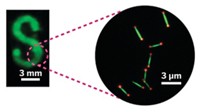Advertisement
Grab your lab coat. Let's get started
Welcome!
Welcome!
Create an account below to get 6 C&EN articles per month, receive newsletters and more - all free.
It seems this is your first time logging in online. Please enter the following information to continue.
As an ACS member you automatically get access to this site. All we need is few more details to create your reading experience.
Not you? Sign in with a different account.
Not you? Sign in with a different account.
ERROR 1
ERROR 1
ERROR 2
ERROR 2
ERROR 2
ERROR 2
ERROR 2
Password and Confirm password must match.
If you have an ACS member number, please enter it here so we can link this account to your membership. (optional)
ERROR 2
ACS values your privacy. By submitting your information, you are gaining access to C&EN and subscribing to our weekly newsletter. We use the information you provide to make your reading experience better, and we will never sell your data to third party members.
Materials
Quantum Dots Detect Long IR Wavelengths
Solution-phase method for making mercury telluride nanocrystals could lower the cost of thermal imaging technology
by Mitch Jacoby
August 25, 2014
| A version of this story appeared in
Volume 92, Issue 34
A low-cost colloidal chemistry method has been used to prepare highly uniform batches of unusually large mercury telluride quantum dots. The investigation broadens the range of control that can be exerted on nanocrystal growth via synthesis methods and provides new materials that could lead to inexpensive detectors for thermal imaging cameras (ACS Nano 2014, DOI: 10.1021/nn503805h). Thermal imaging is widely used for nighttime surveillance and other military and civilian applications. The technology is based on detecting infrared radiation primarily in the 3- to 12-μm range. Common photodetectors for the application are expensive and use single crystals of indium antimonide and mercury cadmium telluride, as well as other materials requiring high-tech fabrication procedures. A team led by the University of Chicago’s Philippe Guyot-Sionnest has now shown that carefully controlling the concentration of the tellurium precursor, reaction temperature, and other parameters leads to selective formation of uniform HgTe crystals up to 20 nm in size. In contrast to earlier studies showing that colloidal HgTe quantum dots could detect IR light with wavelengths up to 7 μm, the new work extends the detection range to the 12 μm needed for complete thermal imaging.




Join the conversation
Contact the reporter
Submit a Letter to the Editor for publication
Engage with us on Twitter